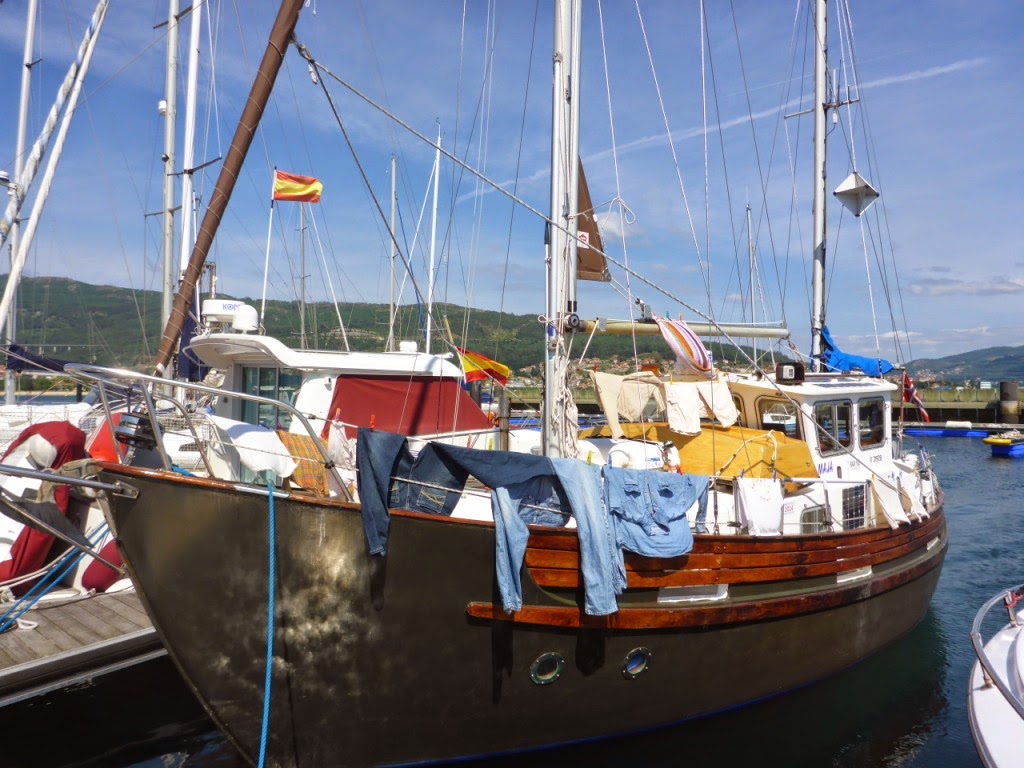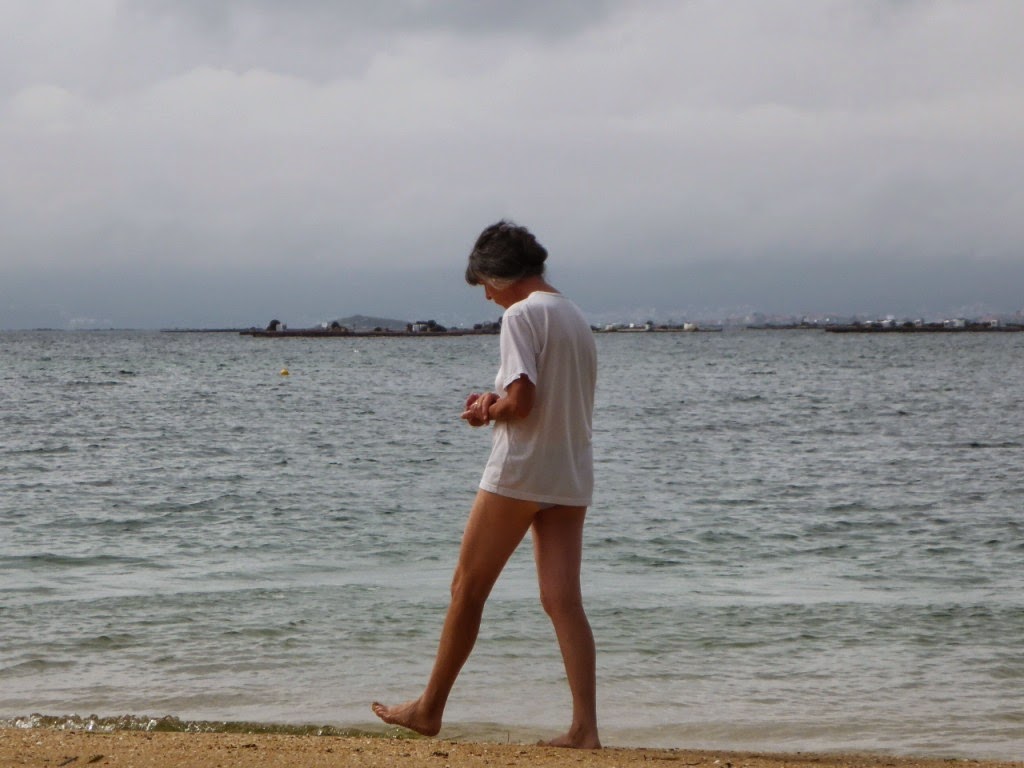Mardi 12 août
2014
Quand nous nous
sommes endormi hier soir, il y avait un peu de vent. Mais quand on se réveille,
cela souffle bien, droit de la mer vers notre ponton et les vagues aussi. Les
cinq voiliers sont en première ligne et dansent pas mal, nous aussi mais un peu
moins. Ils montent et descendent comme
s’ils naviguaient sur des vagues. Le ponton se gondole dans tous les sens. Une
dame d’un voilier descend sur le ponton pour prendre des photos, mais elle a du
mal à se tenir debout et quand elle avance, on dirait qu’elle a trop bu! C’est
inconfortable mais pas dangereux tant que le ponton tient, et il tient. Il faut
tout assurer dans le bateau comme si on partait en mer. Mais on ne peut pas
faire grand chose, qu’attendre que cela passe. Jens va à terre avec l’annexe et
pendant ce temps là je répare le drapeau qui est tout effiloché. J’ai presque le mal de mer tellement ça bouge. Je mets une
photo de la proue de Maja, au dessus du ponton et bien en dessous du ponton
pour vous montrer comme elle bouge. Quand Jens est à terre le chef de port lui
dit qu’il aura une place pour nous dans la marina un peu plus tard.
Il trouve aussi une
place pour le plus petit des voiliers. Jens revient et nous allons tous les
deux à terre pour faire une petite promenade. Nous rencontrons le chef de port,
sur l’eau et il nous dit que la place est libre. Il vient nous chercher avec
son Zodiac et nous aide à la manœuvre, assez délicate avec ce vent. Mais tout se passe bien et notre nouvelle place est parmi
les petits bateaux à moteur de la marina. Nous allons faire notre promenade et,
de notre nouvelle place, nous devons passer un portail qui est fermé. La marina
n’a plus de clé, ils vont faire des copies, mais en attendant il nous faut
enjamber le portail, même pour sortir! Quand nous rentrons, on nous donne une clé.
Sur deux petites plages nous voyons des avis ”Interdit
de se baigner”.
Un voilier part et il ne reste ma
intenant que trois
voiliers en position inconfortable au ponton. On est bien content d’avoir une
“vraie” place, c’est beaucoup plus calme. Nous déjeunons et allons à une grande
plage à l’est de San Vicente, mais il fait gris et nous n’y restons pas
longtemps. En fin d’après midi, le vent baisse
et les trois voiliers partent. Nous dinons et allons faire une promenade sur la
jetée. De place en place, un escalier descend vers la mer (mais a une barrière
en bas) pour permettre aux gens de pêcher.
Tuesday, August
12, 2014
When we went to
bed last night, it was blowing a little. But when we wake up this morning, the
wind is strong, coming from the sea to our pontoon and the waves too. The five yachts
are on the front line and dance a lot, we too, but a little less. They go up
and down as if they were sailing on the waves. The pontoon curls in every
direction. A lady of a sailboat goes down to the pontoon to take pictures, but she
has problem to stand up and when she walks, it looks like she drank too much!
It is uncomfortable but not dangerous so long as the pontoon holds, and it
holds. We must secure everything on the boat as if we going to sea. But there
is not much we can do, only wait for it to pass. Jens goes ashore with the tender
and during that time I repair the flag which is frayed. I am almost seasick doing
it, Maja is moving so much. I put a photo of the bow of Maja, above the pontoon
and well below the pontoon to show you how she moves. When Jens is at the
marina office, the harbor master says that there will be a place for us in the
marina later. He has also a place for the smaller of the five yachts. Jens
comes back and we both goe ashore for a little walk. We meet the head of the harbor,
and he told us that the place is free. He picks us up with his Zodiac and helps
us to move Maja away from the pontoon, it is quite tricky with the wind. But
everything goes well and our new place is among the small motor boats in the
marina. We go for our walk, but from our new place, we must use a gate which is
lost. Even to go out we need a key, and they are short of keys! They are going
do do copies, but right now we have to climb over the gate to go out! On two
small beaches, we see signs "Forbidden to swim".
A yacht leaves
and now ther are only only three yachts moored in the uncomfortable position.
We are glad to have a "real" place, it is much quieter. We have lunch
and go to a big beach east of San Vicente, but it's gray and we do not stay
there long. By late afternoon, the wind decreases and the three yachts depart. We
have dinner and go for a walk on the pier. Here and there, a staircase is built
down to the sea (but with a fence at the bottom) to allow people to fish.
Nos cinq voisins d'en face.
Our five front neighbors
Jens va à terre
Jens rows to land

La proue de Maja au dessus du ponton
Maja's bow over the pontoon
La proue de Maja au dessous du ponton
Maja's bow under the pontoon
Le chef de port nous ramène vers Maja dans son Zodiac
The harbor master takes us back to Maja on his Zodiac
Cela bouge bien
It is really moving
Photo prise le lendemain: le ponton vide et au repos
Picture taken the day after: the pontoon, empty and calm
Nous n'avons pas de clé, il faut enjamber la grille ... pour sortir!
We don't have a key, so we must climb over the gate ... to go out!
Une plage
A beach
Le chef de port nous a trouvé une toute petite place, entre les petits bateaux à moteur
The harbor master found us a very little place between the small motor boats
Un liseron bleu géant
A giant morning glory
(Convolvulus)































































